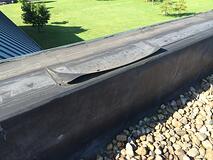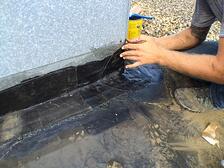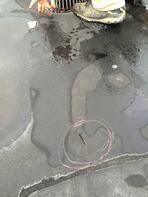A properly installed rubber roof can last for many years but rubber roofing is not without issues. Knowing what to expect from your rubber roof will help you be better prepared to identify and deal with common rubber roof problems as they arise.

1. Rubber roofing shrinks
It's estimated that rubber roofing can shrink as much as 5%. The shrinkage or contraction can have adverse effect on many parts of the flat roof. Rubber adhered to metal edge trims can tear away leaving holes, rubber can pull away from and underneath termination bar and parapet walls, curb flashing and shrinking rubber puts stress on important seams between deck sheets. Shrinking rubber also causes tenting, rubber stretching and lifting away from the deck especially around walls, which can lead to tears and rips from foot traffic.
2. Seams have pulled loose
Large sheets of rubber roofing material must be seamed together. These seams are made by adhering or gluing the two sheets together then running a bead of lap caulking along the seam for added protection against moisture. Overtime ponding water, shrinking rubber, and harsh weather conditions on the roof degrade and desolve the adhesive and glue holding the seams together.
3. Curb and Stack flashings

All rubber roofs curbs around HVAC units and exhaust fans are field fabricated by the roofing crew on the job site. Very often the stack flashing are field fabricated as well, especially large around flashings. It takes skill and experience to consistently create long lasting and water tight rubber roof curbs and stack flashings. Unfortunately not every roofing company has the skill or experience to field fabricate flashings and they are often a source of leaks. The outside corner of the curbs are always the suspect even if they were originally done correctly. Shrinkage can cause the corner to pull away from the transition corner between the side of the curb and roof deck. Stack flashings are most vulnerable at the base where the seams come together.

4. Punctures Easily
Rubber roofing is easily punctured by dropping a sharp tool, a HVAC service panel or by stepping on a screw or debris left behind by maintenance crews. Most rubber roofs are un-reinforced which means it does not have any fabric inside the membrane to give added strength. Once cut or torn, the rubber can "zipper" or quickly allow small rips to become large ones by zippering open. Wind has the ability to blow rubber and cause it to zipper open once its been torn or cut. That small piece of rubber flapping in the breeze can quickly become a large tear and an expensive leak.
By performing regular inspections of your flat rubber roof you can stay on top of the common rubber roof problems.
Also read Repairing Rubber Roof








